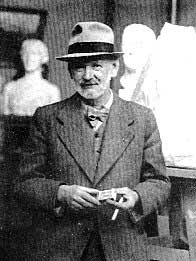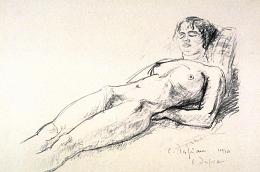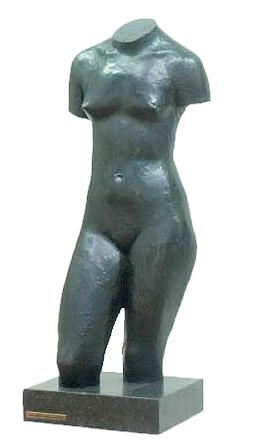Rodin in his time: Biographical materials saved from the Web |
|
|
Charles despiau (Mont-de-Marsan 1874 - Paris 1946) Text source: http://membres.lycos.fr/despiau/gblife.htm "Surely; wrote Bergson, art is simply a more direct vision of reality. But its purity of conception implies a break with due convention, an innate and specially localized detachment of awareness and understanding, and ultimately a certain immateriality of existence—that which has always been called idealism. Hence one could say, without playing on words in any way, that realism exists in a work when idealism exists in the soul, and that solely through ideality can one regain contact with reality" (quoted in Maximilien Gauther's article on Despiau in the newspaper Le Populaire, November 1946). This passage truly applies to the art of Charles Despiau, whom Anatole de Monzie described as the French Donatello.
His artistic adventure—what Deshairs called "the passionate investigation that occupied his entire life"—was indebted to the infinite patience of his friends and wife, Marie, who volunteered to sit for him. Infinite patience was required because Despiau would work without looking at the clock, without necessarily seeking to please. He worked only for himself, sometimes mumbling, "I'm in no hurry. It'll take a year if need be." |
|
|
Untitled (nude woman sleeping) |
Initially, Despiau began exhibiting at the Salon des Artistes Français, from 1898 to 1900. He soon abandoned this overly academic and pompous salon for the one held by the Société Nationale des Beaux Arts, where he showed from 1901 to 1921. Although he became a board member of the Beaux-Arts salon in 1904, he ultimately left it for the Salon d'Automne, and was later one of the founders of the Salon des Tuileries, where he exhibited regularly from 1923 to 1944.At the Beaux-Arts salon of 1907, Despiau showed his bust of Paulette, immediately noticed by Rodin, who hired Despiau as a rougher and pointer. Despiau worked with Rodin, as well as doing his own sculpture, until the outbreak of the First World War, when he was drafted into the camouflage unit along with many other contemporary artists. |
|
After the war, Despiau went back to sculpture and, without either wanting or seeking it, steadily acquired substantial fame. Yet he never changed his modest lifestyle. In 1930, he had a studio built on Rue Brillat-Savarin in Paris—where a great deal of his archives are still stored—because the Villa Corot where he lived and worked was scheduled for demolition. Despiau never sought the fame that finally caught up with him in the 1920s, capped by his highly successful one-man show at the Brummer Gallery in New York late in 1927. Nor did he reject that fame. He simply was not interested in it. Apollon, the last work commissioned by the state in 1936, was to be cast in bronze six meters high and erected in front of the Musée d'Art Moderne in Paris. The statue was scheduled to be installed in late 1938, once the museum was complete. But the sculpture was not ready in time—nor ever really finished, for that matter—and was thus replaced by a work by Emile Antoine Bourdelle, Le Salut de la France aux Alliés. When Apollon was finally cast posthumously, some people saw it as Despiau's "artistic testament." This opinion, however, seems categorically refuted by an undeniable touch of academicism in the work, which bowed to the fashion of the 1930s and 1940s. If Apollon was never cast during Despiau's lifetime, that was perhaps because he was not happy with the plaster state. |
Torse de jeune fille ou l'Adolescence, |
|
His works are currently owned by over thirty museums in France, notably the Centre Beaubourg and Petit Palais in Paris as well as art museums in Bordeaux, Lyon and Grenoble. They can also be found in over 100 museums and foundations abroad (representing twenty-five countries), including some forty museums in the U.S. (such as the Metropolitan Museum and Museum of Modern Art in New York) in addition to the Kunsthaus in Zurich and the Stedelijk Museum in Amsterdam. The largest collection, substantially coming from bequests and gifts by Marie Despiau and, later, his cousin Marcelle Kotlar is still to be found in his native Mont-de-Marsan, in a museum he shares with Robert Wlérick. Despiau produced a total of some 150 sculptures—not a great deal for a career that spanned fifty years. He was so exacting and so focused that the time of execution did not count for him. And if it did not matter to him, he could not see why it should matter to his models. Despiau never sculpted without a model. There are several surviving plaster states in which the same model is reworked with only slight variations. Despiau had a hard time bringing an end to his quest for perfection and the inner beauty of his sitters. His approach was classic in the sense that it was a continuation of Greek and Roman art, and of flamboyant Italian sculpture with its lively, expressive finesse. Yet he never adopted the academicism of the day, any more than Rodin. When Despiau would say to Rodin, "I don't see it that way," Rodin would reply, "Then do it the way you see it." |
|
|
Neither pupil nor simple assistant of Rodin, who respected the emerging artist in him, Despiau never had pupils of his own. In his studio, he welcomed with delight, patience, kindness and benevolence the artists who came to see him and talk "shop" as equals, willingly giving them the advice they sought. His oeuvre includes over 1,000 drawings and approximately 150 sculptures (bas-reliefs, tablets, figures, and busts). It is worth mentioning Assia (his most widely reproduced work, perhaps his masterpiece), La Bacchante, Le Nu Assis, Eve, Le Réalisateur, Apollon, La Petite Fille des Landes (his native region), La Jeune Fille des Landes, Cra-Cra, and L'Adolescente. Then there are portraits of Paulette, Madame Derain, Maria Lani, Agnès Meyer, Mademoiselle Elie Faure and Princess Murat, as well as several portraits of men including Claude-Raphaël Leygues and Despiau's friend André Dunoyer de Segonzac. Charles Despiau 1874-1946 Published in: Ronald Alley, Catalogue of the Tate Gallery's Collection of Modern Art other than Works by British Artists, Tate Gallery and Sotheby Parke-Bernet, London 1981, p.169 French sculptor of portrait busts and full-length nude figures, standing or seated; also draughtsman. Born at Mont-de-Marsan (Landes), son of a master-plasterer. Moved to Paris when seventeen and studied sculpture at the Ecole des Arts D-23coratifs 1891-3 under Lemaire, a pupil of Carpeaux, and at the Ecole des Beaux-Arts 1893-6 under Barrias. First exhibited at the Salon des Artistes Fran-25ais in 1898. In poverty for many years and was even obliged to colour picture postcards for a living. Worked as assistant to Rodin 1907-14, but turned to a more static and generalised style. Made several monuments, including a war memorial at Mont-de-Marsan 1920-2, and a few low-reliefs, but most of his works are portrait busts of female sitters in a quietly contemplative mood. Taught from 1923 at the Grande Chaumi-24re. First one-man exhibition at the Brummer Gallery, New York, 1927. Bought a country house at Hossegor (Landes) in 1932. Died in Paris.
Biografie Quelle: http://www.europaeische-kultur-stiftung.org/aufgaben/despiau.html
1874
|
|
|
|
|
|
Notice:
Museum logos appear only as buttons linking to Museum Websites and do not
imply any |
|
 Granted
a regional scholarship, Despiau first attended the Ecole des Arts Décoratifs
and later the
Ecole des Beaux Arts where he quickly realized, according to
Léon Deshairs, that "anatomy isn't sculpture" and that he
wasn't suited to the "glorification of biceps and triceps." He
therefore increasingly cut classes (where he learned basic techniques) in
order to visit museums and work extensively at home.
Granted
a regional scholarship, Despiau first attended the Ecole des Arts Décoratifs
and later the
Ecole des Beaux Arts where he quickly realized, according to
Léon Deshairs, that "anatomy isn't sculpture" and that he
wasn't suited to the "glorification of biceps and triceps." He
therefore increasingly cut classes (where he learned basic techniques) in
order to visit museums and work extensively at home.

